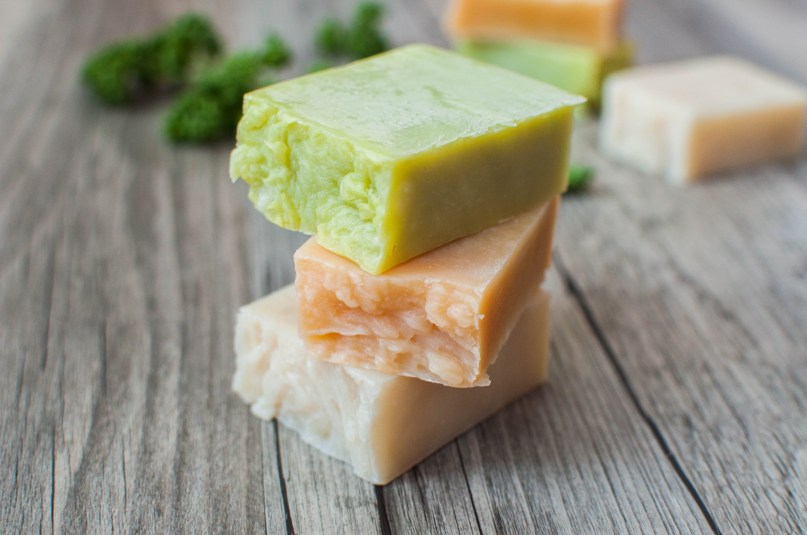You Can Easily Make Organic Soap at Home — Here’s How

It might have been practiced since ancient Roman times, but there’s never been a better time to try soap making than right now.
For a start, washing our hands has never been more important than during COVID-19. Making your own soap is an easy and cheap way to keep yourself in a constant supply of the germ-fighting stuff.
What’s more, with so many shop-bought soaps still covered in plastic packaging, DIY soap is a sure-fire way to keep clean while protecting the planet.
And it’s fun! There are lots of different soap making projects you can try, but the two we’re going to share with you — one for a soap bar and one for hand soap — are some of the simplest and most fun to try from your own home. Once you get the hang of it, you could even branch out into making soaps as a lovely gift for friends and loved ones.
Finally, several shop-bought soaps contain a number of chemicals and additives . Making your own, however, makes sure that you know everything that’s going in your soap and onto your skin. For that reason, we’ve picked two totally natural recipes. While many projects make soap using lye (the common name for sodium hydroxide), which is caustic when it touches the skin and can be hazardous to work with at home, our projects are lye-free — meaning it’s safe, natural, and easy to do while at home.
How to make bar soap without lye.
What you will need:
- Soap base
- Pan or heat-resistant container
- Wire whisk
- Essential oils
- Soap dyes or spice (optional)
- Soap mould or silicone mold
The easiest technique for making soap without having to touch lye is called “melt-and-pour.”
The idea is that you buy a pre-made base that you melt, customize with your favorite colors and smells, and then pour into a mold.
You can buy soap bases from a variety of online outlets as well as at many craft stores. We like The Soap Kitchen’s collection, which offers a range of bases, from Soil Association-certified soaps to ones made with olive oil or goat’s milk.
Once you have your soap base, follow the instructions on the packet to see how long to heat your base for. You can usually do this either in a pan on medium-low heat on the stove or in a heat-safe container in the microwave. If using the microwave, only heat the base in short bursts so you can keep an eye on when it starts to melt. Avoid stirring the mixture as it’s melting but at the point, all the base is fully melted.
Once the soap is melted, take it off the heat or remove it from the microwave. This is where you need to move fairly speedily as the soap easily solidifies — if that happens, though, simply pop it back on the heat just for a few moments.
Now place your container on a heat resistant surface and stir in a fragrance of your choice using essential oils of your choice. Usually, about 1 teaspoon of fragrance per pound of soap base works well.
You can also choose to add dried herbs for texture or color — dried lavender flowers rosemary, chamomile flowers, or calendula all work beautifully. And to make it even prettier, add some color either using soap dyes (available in most craft stores) or add color naturally with spices such as cinnamon, ground coffee, or beetroot. Lovely Greens have some great ideas for adding natural colors to soaps.
Use a wire whisk to stir everything evenly through the mixture.
Then, once you’re happy with the mixture, pour it into pre-prepared molds, filling them as close to the top as possible as the soap won’t expand. You can buy molds in most craft shops and online in all sorts of shapes and sizes. If it’s a gift, maybe consider a fun mold like dinosaur-shaped molds ($3, Shein) or seashell themed molds ($4.49, The Soap Kitchen).
Finally, leave your homemade soap to cool at room temperature in the mold, placed on a flat surface. Try not to touch it while it cools — this could take one to 24 hours depending on the size of the soap. But once hard, pop it out of the mold and enjoy.
How to make liquid hand soap.
Hand soap is so deceptively simple to make, you’ll soon wonder why you ever bothered to buy the stuff.
To get started, you’ll need an empty 8 oz. container. You can recycle an old used bottle if you like, but you’ll need to clean out the dispenser really well by filling it with water, pumping the water through the dispenser, and then emptying. Alternatively, you can easily buy by refillable soap dispensers online.
Then simply fill your container with water until it’s nearly full. Then add 2 tbsp of liquid castile soap to the top. Any castile soap will do, but we like the organic ones.
Finally, for a nice scent, add a couple of drops of your favorite essential oils. Citrus smells are perfect for the kitchen, while rose or lavender might be more relaxing for the bathroom. You can even mix more than one scent together if you’re feeling adventurous such as lavender and rosemary or peppermint and lemon.
This article originally appeared on our sister site, Yours.
















